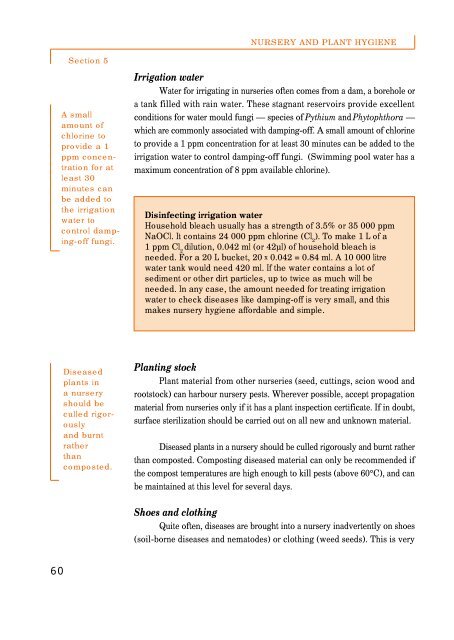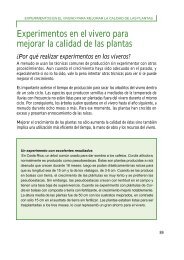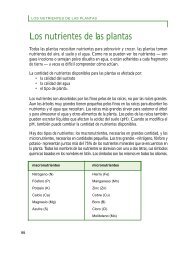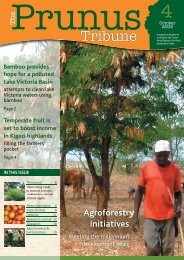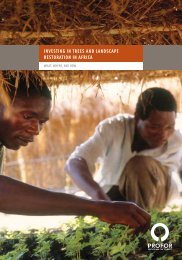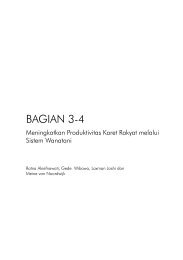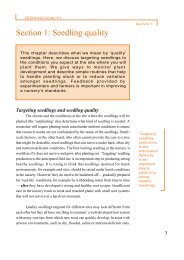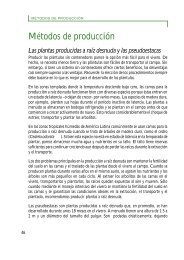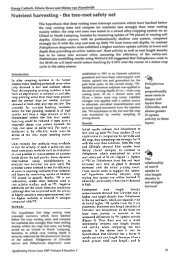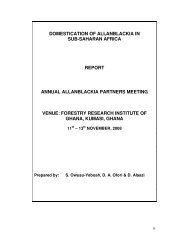Section 5: Nursery and plant hygiene - World Agroforestry Centre
Section 5: Nursery and plant hygiene - World Agroforestry Centre
Section 5: Nursery and plant hygiene - World Agroforestry Centre
You also want an ePaper? Increase the reach of your titles
YUMPU automatically turns print PDFs into web optimized ePapers that Google loves.
NURSERY AND PLANT HYGIENE<strong>Section</strong> 5A smallamount ofchlorine toprovide a 1ppm concentrationfor atleast 30minutes canbe added tothe irrigationwater tocontrol damping-offfungi.Irrigation waterWater for irrigating in nurseries often comes from a dam, a borehole ora tank filled with rain water. These stagnant reservoirs provide excellentconditions for water mould fungi — species of Pythium <strong>and</strong> Phytophthora —which are commonly associated with damping-off. A small amount of chlorineto provide a 1 ppm concentration for at least 30 minutes can be added to theirrigation water to control damping-off fungi. (Swimming pool water has amaximum concentration of 8 ppm available chlorine).Disinfecting irrigation waterHousehold bleach usually has a strength of 3.5% or 35 000 ppmNaOCl. It contains 24 000 ppm chlorine (Cl 2). To make 1 L of a1 ppm Cl 2dilution, 0.042 ml (or 42µl) of household bleach isneeded. For a 20 L bucket, 20 x 0.042 = 0.84 ml. A 10 000 litrewater tank would need 420 ml. If the water contains a lot ofsediment or other dirt particles, up to twice as much will beneeded. In any case, the amount needed for treating irrigationwater to check diseases like damping-off is very small, <strong>and</strong> thismakes nursery <strong>hygiene</strong> affordable <strong>and</strong> simple.Diseased<strong>plant</strong>s ina nurseryshould beculled rigorously<strong>and</strong> burntratherthancomposted.Planting stockPlant material from other nurseries (seed, cuttings, scion wood <strong>and</strong>rootstock) can harbour nursery pests. Wherever possible, accept propagationmaterial from nurseries only if it has a <strong>plant</strong> inspection certificate. If in doubt,surface sterilization should be carried out on all new <strong>and</strong> unknown material.Diseased <strong>plant</strong>s in a nursery should be culled rigorously <strong>and</strong> burnt ratherthan composted. Composting diseased material can only be recommended ifthe compost temperatures are high enough to kill pests (above 60°C), <strong>and</strong> canbe maintained at this level for several days.Shoes <strong>and</strong> clothingQuite often, diseases are brought into a nursery inadvertently on shoes(soil-borne diseases <strong>and</strong> nematodes) or clothing (weed seeds). This is very60


